Applications of Machine Learning and High-Performance Computing in the Era of COVID-19
Abstract
:1. Introduction
2. Insights on Data Collection and Analytics Opportunities in the COVID-19 Era
- Finding the most exposed people through location analysis (e.g., church/moviegoers).
- Extraction of people where physical presence for a job is mandatory.
- Identification of people working in high-risk zones.
- Alerting people when they have a high chance of getting COVID-19.
- Cluster identification by fusing multiple source data.
- Analyzing contact among people and predicting the risk score based on multicriteria.
- Identifying close contacts in a privacy-preserving manner.
- Analyzing the dynamics of the disease with respect to age groups.
- Identifying lethal combinations of the diseases to lower mortality chances.
- Providing the probability of infection score based on multiple parameters.
- Finding the connection of the diseases and demographics to better guide people to improve their health.
- Analyzing the dynamics of the disease with ambient conditions.
- Analyzing the correlation between symptoms and ICU transfer for resource planning.
- Predicting discharge dates based on demographics and comorbidity data.
3. Effectiveness of ML and HPC Techniques in the COVID-19 Era
3.1. ML and HPC Techniques’ Role in the Data Management Life Cycle
3.2. Role of ML and HPC Techniques in Data Analytics in the COVID-19 Era
3.3. Role of ML and HPC Techniques in the General-Purpose Applications Related to the COVID-19 Era
- Creating awareness about COVID-19 through sentiment analysis and recommending health tips.
- Regional- and community-level analysis of electronic health records of confirmed/ suspected COVID-19 cases.
- Providing medical statistics about COVID-19 symptoms from real case data.
- Providing the locality of hospitals and clinics.
- Increasing data utility by recommending/sharing results on cell phones.
- Processing and utilization of cell phone signal data for people identification.
- Extracting and fusing multistyle data for accurate analysis.
- Combining multimodel results to erase people’s anxiety on results’ credibility.
- Analyzing and sharing human behavior for vulnerable links identification in the community.
- Analyzing the technology implications on society through relevant features.
4. Discussion
4.1. Data-Related Challenges That Hinder the Effective Utilization of ML and HPC Techniques
- Unavailability of the benchmark datasets.
- Data availability at a very limited scale.
- Data contain a substantial number of missing/incomplete records.
- Data are highly unreliable, as they are collected through privacy enforcement.
- Data are in inconsistent styles; therefore. fusion is not easy.
- Data are highly skewed and sparse.
- Data are related to only some communities (i.e., minorities).
- Data cannot provide sufficient insights about the disease dynamics.
- Data cannot assist in making effective policies to separate vulnerable communities (e.g., comorbidity data are not shared mostly).
- Data do not provide all dynamics related to COVID-19.
- Data do not support full-scale adoption of ML and HPC techniques due to privacy and security issues.
4.2. Privacy and Security Issues
4.3. Architecture of Prototype System to Demonstrate the Effectiveness of AI and HPC Techniques in COVID Context
- Data collection: In this module, data are collected from relevant individuals and authentic sources such as healthcare departments and agencies. We identify three main sources of data that can contribute effectively to this pandemic, such as real-environment data (including social distancing, mask information, nature of contact with other people, spatiotemporal-based activities data, social circle information, etc.), authentic healthcare departments data (including previous disease history, travel information, ambient data, etc.), and IoT and SN data (including people behaviors).
- Data processing and analytics leveraging ML and HPC techniques: In this module, data are processed with multiple ML techniques for the possibility of infections estimation, spread predictions, and spatiotemporal information correlation for COVID-19 spread hidden route identifications. The role of HPC is to provide support during data processing and storing intermediate results at a massive scale.
- Results utilization for disease mitigation and control: In this module, results are disseminated to the relevant parties (e.g., general people, health officials, and government officials). The sharing of results with relevant parties accurately and timely contributes significantly to disease mitigation and control.
4.4. Comprehensive Overview of the Current State-of-the-Art Research Involving the Use of ML and HPC Methods in the Era of COVID-19
4.5. Promising Research Directions for Future in the Era of COVID-19
5. Conclusions
- It presents an overview of epidemic features that require ML and HPC techniques to serve humankind in an effective way by controlling the pandemic through technology.
- It describes the multitude of heterogeneous types of data collected in the COVID-19 era and the remarkable opportunities they offer when analyzed with advanced ML and HPC techniques.
- It highlights the effectiveness of ML and HPC techniques in the mitigation and control of the COVID-19 pandemic through their unique use in three contexts.
- It provides potential research directions and challenges that hinder the adoption of ML and HPC due to data issues (i.e., availability, sparsity, data poisoning, etc.)
- It discusses the privacy and security issues and architecture of a prototype system to demonstrate the proposed research.
- To the best of our knowledge, this is the first work to provide a concise overview of the ML and HPC techniques used in the COVID-19 era with respective data in loop.
Author Contributions
Funding
Institutional Review Board Statement
Informed Consent Statement
Data Availability Statement
Conflicts of Interest
References
- Hale, T.; Angrist, N.; Goldszmidt, R.; Kira, B.; Petherick, A.; Phillips, T.; Webster, S.; Cameron-Blake, E.; Hallas, L.; Majumdar, S.; et al. A global panel database of pandemic policies (Oxford COVID-19 Government Response Tracker). Nat. Hum. Behav. 2021, 5, 529–538. [Google Scholar] [CrossRef]
- Mbunge, E.; Akinnuwesi, B.; Fashoto, S.G.; Metfula, A.S.; Mashwama, P. A critical review of emerging technologies for tackling COVID-19 pandemic. Hum. Behav. Emerg. Technol. 2021, 3, 25–39. [Google Scholar] [CrossRef]
- Bijan, M. Developed Technologies and Active Startup Companies in Dealing with COVID-19 Pandemic in Iran. J. Control 2021, 14, 97–105. [Google Scholar]
- Mbunge, E.; Dzinamarira, T.; Fashoto, S.G.; Batani, J. Emerging technologies and COVID-19 Digital Vaccination Certificates and Passports. Public Health Pract. 2021, 2, 100136. [Google Scholar] [CrossRef] [PubMed]
- Wen, H.; Zhao, Q.; Lin, Z.; Xuan, D.; Shroff, N. A study of the privacy of covid-19 contact tracing apps. In International Conference on Security and Privacy in Communication Systems; Springer: Cham, Switzerland, 2020; pp. 297–317. [Google Scholar]
- Apedo-Amah, M.C.; Avdiu, B.; Cirera, X.; Cruz, M.; Davies, E.; Grover, A.; Iacovone, L.; Kilinc, U.; Medvedev, D.; Maduko, F.O.; et al. Unmasking the impact of covid-19 on businesses: Firm level evidence from across the world. Policy Res. Work. Pap. 2020. [Google Scholar] [CrossRef]
- Wieringa, J.; Kannan, P.K.; Ma, X.; Reutterer, T.; Risselada, H.; Skiera, B. Data analytics in a privacy-concerned world. J. Bus. Res. 2021, 122, 915–925. [Google Scholar] [CrossRef]
- Mirsky, J.B.; Horn, D.M. Chronic disease management in the COVID-19 era. Am. J. Manag. Care 2020, 26, 329–330. [Google Scholar]
- Cortés, U.; Cortés, A.; Garcia-Gasulla, D.; Pérez-Arnal, R.; Álvarez-Napagao, S.; Àlvarez, E. The ethical use of high-performance computing and artificial intelligence: Fighting COVID-19 at Barcelona Supercomputing Center. AI Ethics 2021, 1–16. [Google Scholar] [CrossRef]
- Al-Emran, M.; Al-Kabi, M.N.; Marques, G. A Survey of Using Machine Learning Algorithms During the COVID-19 Pandemic. In Emerging Technologies During the Era of COVID-19 Pandemic; Springer: Cham, Switzerland, 2021; Volume 348, pp. 1–8. [Google Scholar]
- Swapnarekha, H.; Behera, H.S.; Nayak, J.; Naik, B. Role of intelligent computing in COVID-19 prognosis: A state-of-the-art review. ChaosSolitons Fractals 2020, 138, 109947. [Google Scholar] [CrossRef]
- Elnaggar, A.; Heinzinger, M.; Dallago, C.; Rihawi, G.; Wang, Y.; Jones, L.; Gibbs, T.; Feher, T.; Angerer, C.; Steinegger, M.; et al. ProtTrans: Towards Cracking the Language of Life’s Code Through Self-Supervised Deep Learning and High Performance Computing. arXiv 2020, arXiv:2007.06225. [Google Scholar]
- Arora, A.; Chakraborty, P.; Bhatia, M.P.S. Problematic use of digital technologies and its impact on mental health during COVID-19 pandemic: Assessment using machine learning. Emerg. Technol. Dur. Era COVID-19 Pandemic 2021, 348, 197–221. [Google Scholar]
- Zivkovic, M.; Bacanin, N.; Venkatachalam, K.; Nayyar, A.; Djordjevic, A.; Strumberger, I.; Al-Turjman, F. COVID-19 cases prediction by using hybrid machine learning and beetle antennae search approach. Sustain. Cities Soc. 2021, 66, 102669. [Google Scholar] [CrossRef]
- Majeed, A. Attribute-centric anonymization scheme for improving user privacy and utility of publishing e-health data. J. King Saud Univ. Comput. Inf. Sci. 2019, 31, 426–435. [Google Scholar] [CrossRef]
- Michael, V. Privacy is not the problem with the Apple-Google contact-tracing toolkit. Guard. 2020. Available online: https://www.theguardian.com/commentisfree/2020/jul/01/apple-google-contact-tracing-app-tech-giant-digital-rights (accessed on 5 May 2021).
- Abdul, M. Towards Privacy Paradigm Shift Due to the Pandemic: A Brief Perspective. Inventions 2021, 6, 24. [Google Scholar]
- Sowmiya, B.; Abhijith, V.S.; Sudersan, S.; Sundar, R.S.J.; Thangavel, M.; Varalakshmi, P. A Survey on Security and Privacy Issues in Contact Tracing Application of Covid-19. SN Comput. Sci. 2021, 2, 1–11. [Google Scholar] [CrossRef] [PubMed]
- Mallory, K. Public Health, Big Tech, and Privacy Squaring the Contact-Tracing Circle. COVID-19 and the Information Space Boosting the Democratic Response, Global Insights. p. 44. Available online: https://www.ned.org/wp-content/uploads/2021/01/Global-Insights-COVID-19-Information-Space-Boosting-Democratic-Response-1.pdf-page=44 (accessed on 5 May 2021).
- McGraw, D.; Mandl, K.D. Privacy protections to encourage use of health-relevant digital data in a learning health system. NPJ Digit. Med. 2021, 4, 1–11. [Google Scholar] [CrossRef] [PubMed]
- Shin, S.-Y. Privacy Protection and Data Utilization. Healthc. Inform. Res. 2021, 27, 1–2. [Google Scholar] [CrossRef] [PubMed]
- Kleinman, R.A.; Merkel, C. Digital contact tracing for COVID-19. CMAJ 2020, 192, E653–E656. [Google Scholar] [CrossRef]
- Garg, L.; Chukwu, E.; Nasser, N.; Chakraborty, C.; Garg, G. Anonymity preserving IoT-based COVID-19 and other infectious disease contact tracing model. IEEE Access 2020, 8, 159402–159414. [Google Scholar] [CrossRef]
- Fang, C.; Bai, S.; Chen, Q.; Zhou, Y.; Xia, L.; Qin, L.; Gong, S.; Xie, X.; Zhou, C.; Tu, D.; et al. Deep learning for predicting COVID-19 malignant progression. Med. Image Anal. 2021, 72, 102096. [Google Scholar] [CrossRef]
- Wang, B.; Jin, S.; Yan, Q.; Xu, H.; Luo, C.; Wei, L.; Zhao, W.; Hou, X.; Ma, W.; Xu, Z.; et al. AI-assisted CT imaging analysis for COVID-19 screening: Building and deploying a medical AI system. Appl. Soft Comput. 2021, 98, 106897. [Google Scholar] [CrossRef] [PubMed]
- Banjar, H.R.; Alkhatabi, H.; Alganmi, N.; Almouhana, G.I. Prototype Development of an Expert System of Computerized Clinical Guidelines for COVID-19 Diagnosis and Management in Saudi Arabia. Int. J. Environ. Res. Public Health 2020, 17, 8066. [Google Scholar] [CrossRef] [PubMed]
- Mukhtar, H.; Rubaiee, S.; Krichen, M.; Alroobaea, R. An IoT Framework for Screening of COVID-19 Using Real-Time Data from Wearable Sensors. Int. J. Environ. Res. Public Health 2021, 18, 4022. [Google Scholar] [CrossRef] [PubMed]
- Pinter, G.; Felde, I.; Mosavi, A.; Ghamisi, P.; Gloaguen, R. COVID-19 Pandemic Prediction for Hungary; a Hybrid Machine Learning Approach. Mathematics 2020, 8, 890. [Google Scholar] [CrossRef]
- Magar, R.; Yadav, P.; Farimani, A.B. Potential neutralizing antibodies discovered for novel corona virus using machine learning. Sci. Rep. 2021, 11, 5261. [Google Scholar] [CrossRef]
- Aminu, M.; Ahmad, N.A.; Noor, M.H.M. Covid-19 detection via deep neural network and occlusion sensitivity maps. Alex. Eng. J. 2021, 60, 4829–4855. [Google Scholar] [CrossRef]
- Zeng, W.; Gautam, A.; Huson, D.H. On the Application of Advanced Machine Learning Methods to Analyze Enhanced, Multimodal Data from Persons Infected with COVID-19. Computation 2021, 9, 4. [Google Scholar] [CrossRef]
- Shah, P.M.; Ullah, F.; Shah, D.; Gani, A.; Maple, C.; Wang, Y.; Shahid, A.; Abrar, M.; Islam, S.U. Deep GRU-CNN model for COVID-19 detection from chest X-rays data. IEEE Access 2021. [Google Scholar] [CrossRef]
- Ashraf, I.; Alnumay, W.S.; Ali, R.; Hur, S.; Bashir, A.K.; Zikria, Y.B. Prediction Models for COVID-19 Integrating Age Groups, Gender, and Underlying Conditions. Comput. Mater. Contin. 2021, 67, 3009–3044. [Google Scholar] [CrossRef]
- Prakash, P.N.S.; Hariharan, B.; Kaliraj, S.; Siva, R.; Vivek, D. The impact of various policy factors implemented for controlling the spread of COVID-19. Mater. Today Proc. 2021. [Google Scholar] [CrossRef]
- Ullah, S.I.; Salam, A.; Ullah, W.; Imad, M. COVID-19 lung image classification based on logistic regression and support vector machine. In European, Asian, Middle Eastern, North African Conference on Management & Information Systems; Springer: Cham, Switzerland, 2021; pp. 13–23. [Google Scholar]
- Rathod, P.; Usoro, A. Benchmarking Machine Learning Approaches to Predict the Uncertainties of Pandemic Disease: An Explorative Study. In Proceedings of the 7th Annual International Conference on Information Technology and Economic Development, Gregory University, Uturu, Nigeria, 16–18 November 2020. [Google Scholar]
- Al Meshal, R.A.K.H. The Impact of COVID-19 on Arabian Gulf Countries Using the Classical Machine Learning Methods. MECSJ. 2021. Available online: https://www.mecsj.com/uplode/images/photo/The_impact_of_COVID-19_on_Arabian_Gulf_countries_using_the_Classical_Machine_Learning_Methods.pdf (accessed on 30 June 2021).
- Rashed, E.A.; Hirata, A. One-Year Lesson: Machine Learning Prediction of COVID-19 Positive Cases with Meteorological Data and Mobility Estimate in Japan. Int. J. Environ. Res. Public Health 2021, 18, 5736. [Google Scholar] [CrossRef]
- Hu, F.; Huang, M.; Sun, J.; Zhang, X.; Liu, J. An analysis model of diagnosis and treatment for COVID-19 pandemic based on medical information fusion. Inf. Fusion 2021, 73, 11–21. [Google Scholar] [CrossRef] [PubMed]
- Singh, D.; Kumar, V.; Kaur, M. Densely connected convolutional networks-based COVID-19 screening model. Appl. Intell. 2021, 51, 3044–3051. [Google Scholar] [CrossRef]
- Peddinti, B.; Shaikh, A.; Bhavya, K.R.; Nithin Kumar, K.C. Framework for Real-Time Detection and Identification of possible patients of COVID-19 at public places. Biomed. Signal Process. Control 2021, 68, 102605. [Google Scholar] [CrossRef]
- Saverino, A.; Baiardi, P.; Galata, G.; Pedemonte, G.; Vassallo, C.; Pistarini, C. The Challenge of Reorganizing Rehabilitation Services at the Time of COVID-19 Pandemic: A New Digital and Artificial Intelligence Platform to Support Team Work in Planning and Delivering Safe and High Quality Care. Front. Neurol. 2021, 12, 643251. [Google Scholar] [CrossRef] [PubMed]
- Lella, K.K.; Pja, A. Automatic COVID-19 disease diagnosis using 1D convolutional neural network and augmentation with human respiratory sound based on parameters: Cough, breath, and voice. AIMS Public Health 2021, 8, 240. [Google Scholar] [CrossRef] [PubMed]
- Malla, S.; Alphonse, P.J.A. COVID-19 outbreak: An ensemble pre-trained deep learning model for detecting informative tweets. Appl. Soft Comput. 2021, 107, 107495. [Google Scholar] [CrossRef]
- Ibrahim, M.R.; Youssef, S.M.; Fathalla, K.M. Abnormality detection and intelligent severity assessment of human chest computed tomography scans using deep learning: A case study on SARS-COV-2 assessment. J. Ambient Intell. Humaniz. Comput. 2021, 1–24. [Google Scholar] [CrossRef]
- Roland, T.; Boeck, C.; Tschoellitsch, T.; Maletzky, A.; Hochreiter, S.; Meier, J.; Klambauer, G. Machine Learning based COVID-19 Diagnosis from Blood Tests with Robustness to Domain Shifts. medRxiv 2021. [Google Scholar] [CrossRef]
- Gros, C.; Valenti, R.; Schneider, L.; Gutsche, B.; Markovi´c, D. Predicting the cumulative medical load of COVID-19 outbreaks after the peak in daily fatalities. PLoS ONE 2021, 16, e0247272. [Google Scholar] [CrossRef]
- Hack, J.J.; Papka, M.E. The US High-Performance Computing Consortium in the Fight Against COVID-19. Comput. Sci. Eng. 2020, 22, 75–80. [Google Scholar] [CrossRef]
- West, J. Large-Scale Scientific Computing in the Fight Against COVID-19. Comput. Sci. Eng. 2021, 23, 89–92. [Google Scholar] [CrossRef]
- LeGrand, S.; Scheinberg, A.; Tillack, A.F.; Thavappiragasam, M.; Vermaas, J.V.; Agarwal, R.; Larkin, J.; Poole, D.; Santos-Martins, D.; Solis-Vasquez, L.; et al. GPU-accelerated drug discovery with docking on the summit supercomputer: Porting, optimization, and application to COVID-19 research. In Proceedings of the 11th ACM International Conference on Bioinformatics, Computational Biology and Health Informatics, Virtual Event, USA, 21–24 September 2020; pp. 1–10. [Google Scholar]
- Vermaas, J.V.; Sedova, A.; Baker, M.; Boehm, S.; Rogers, D.; Larkin, J.; Glaser, J.; Smith, M.; Hernandez, O.; Smith, J. Supercomputing Pipelines Search for Therapeutics Against COVID-19. Comput. Sci. Eng. 2020, 23, 7–16. [Google Scholar] [CrossRef]
- Pérez-Moraga, R.; Forés-Martos, J.; Suay-García, B.; Duval, J.; Falcó, A.; Climent, J. A COVID-19 Drug Repurposing Strategy through Quantitative Homological Similarities Using a Topological Data Analysis-Based Framework. Pharmaceutics 2021, 13, 488. [Google Scholar] [CrossRef]
- Mulholland, A.J.; Amaro, R.E. COVID19-Computational Chemists Meet the Moment. J. Chem. Inf. Model. 2020, 60, 5724–5726. [Google Scholar] [CrossRef]
- Zaki Magdi, E.A.; Al-Hussain, S.A.; Masand, V.H.; Akasapu, S.; Bajaj, S.O.; El-Sayed, N.N.E.; Ghosh, A.; Lewaa, I. Identification of Anti-SARS-CoV-2 Compounds from Food Using QSAR-Based Virtual Screening, Molecular Docking, and Molecular Dynamics Simulation Analysis. Pharmaceuticals 2021, 14, 357. [Google Scholar] [CrossRef] [PubMed]
- Pathak, N.; Deb, P.K.; Mukherjee, A.; Misra, S. IoT-to-the-Rescue: A Survey of IoT Solutions for COVID-19-like Pandemics. IEEE Internet Things J. 2021. [Google Scholar] [CrossRef]
- Bhati, A.P.; Wan, S.; Alfè, D.; Clyde, A.R.; Bode, M.; Tan, L.; Titov, M.; Merzky, A.; Turilli, M.; Jha, S.; et al. Pandemic Drugs at Pandemic Speed: Accelerating COVID-19 Drug Discovery with Hybrid Machine Learning-and Physics-based Simulations on High Performance Computers. arXiv 2021, arXiv:2103.02843. [Google Scholar]
- Bharadwaj, K.K.; Srivastava, A.; Panda, M.K.; Singh, Y.D.; Maharana, R.; Mandal, K.; Singh, B.S.M.; Singh, D.; Das, M.; Murmu, D.; et al. Computational intelligence in vaccine design against COVID-19. In Computational Intelligence Methods in COVID-19: Surveillance, Prevention, Prediction and Diagnosis; Springer: Singapore, 2021; pp. 311–329. [Google Scholar]
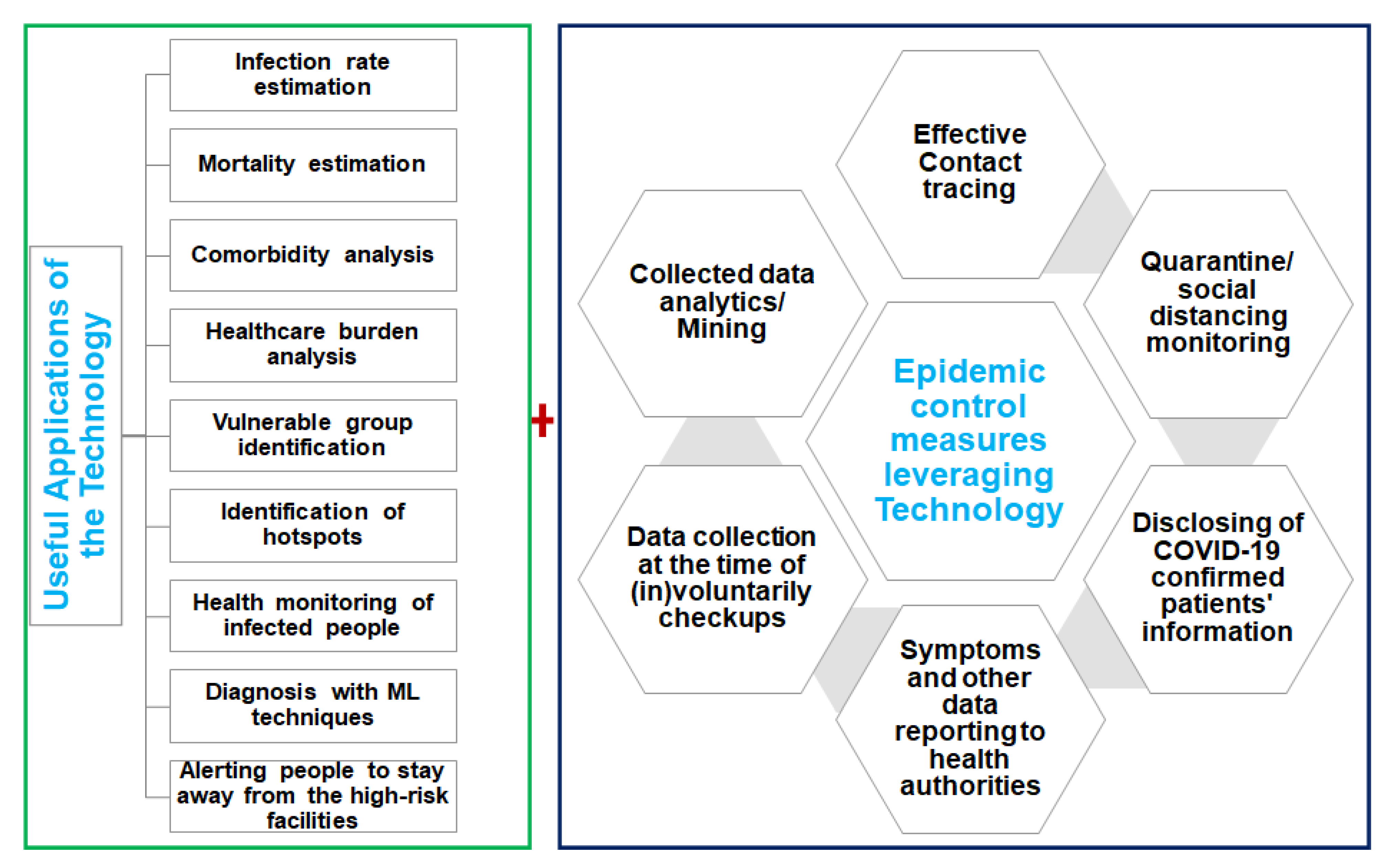

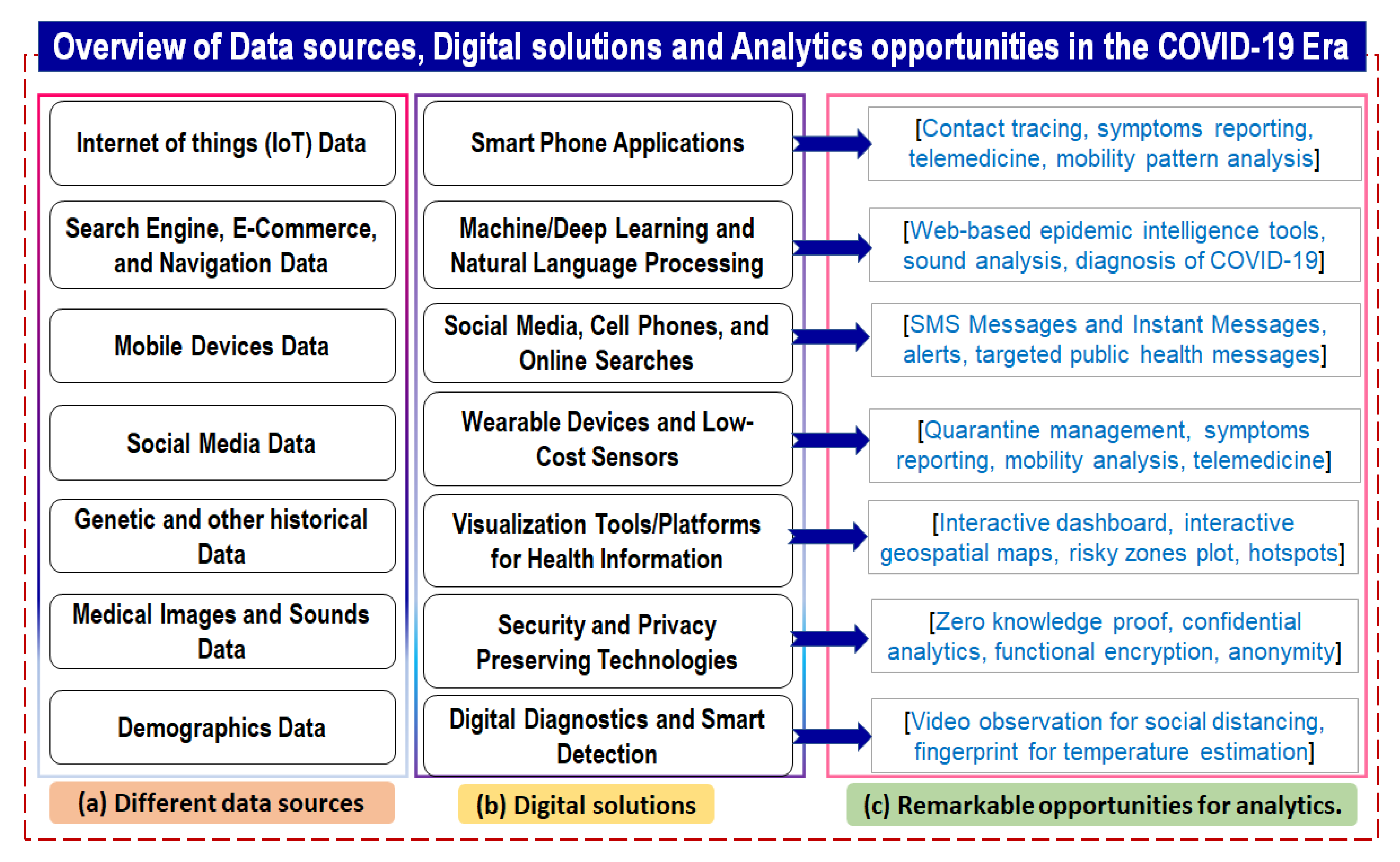
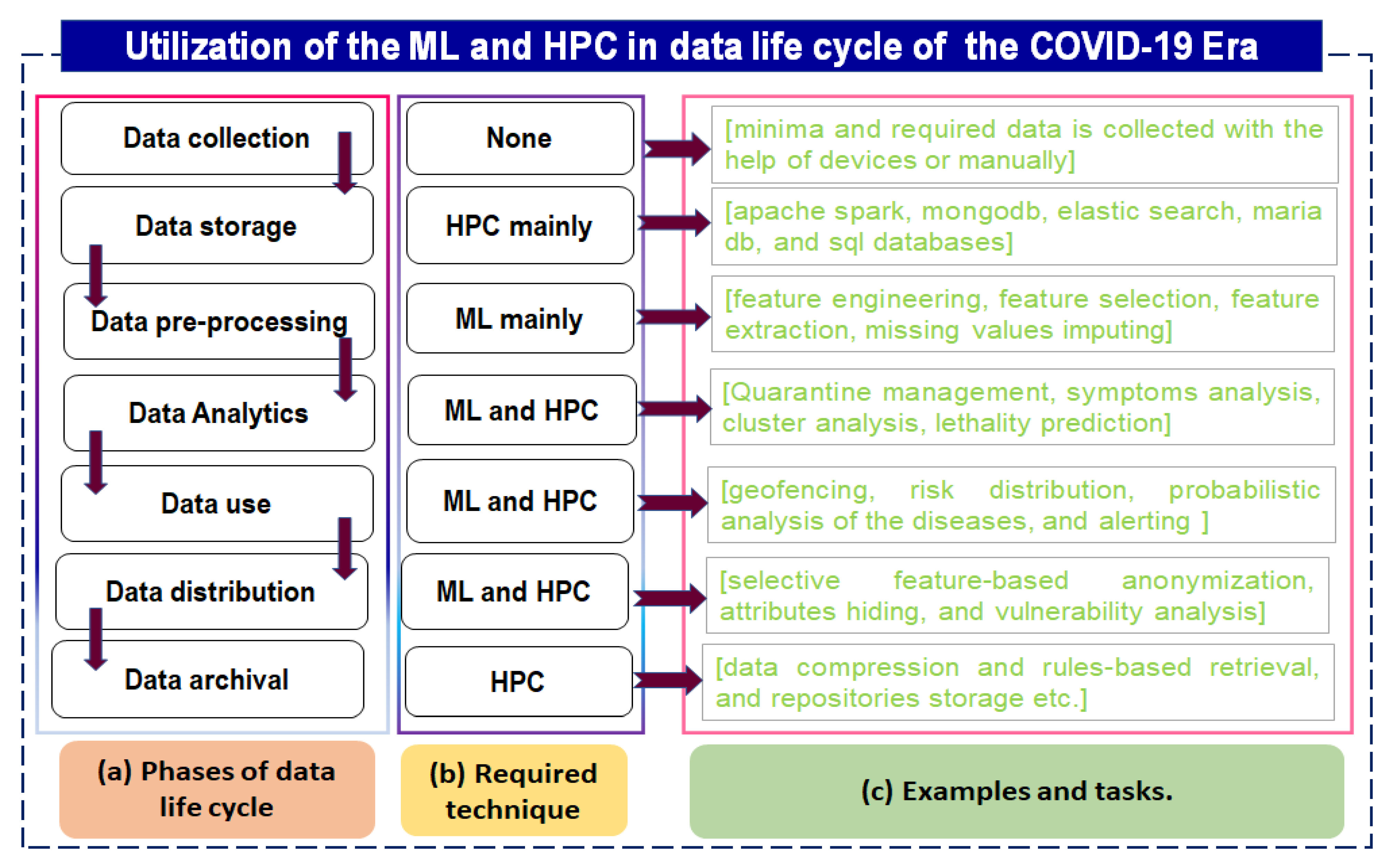
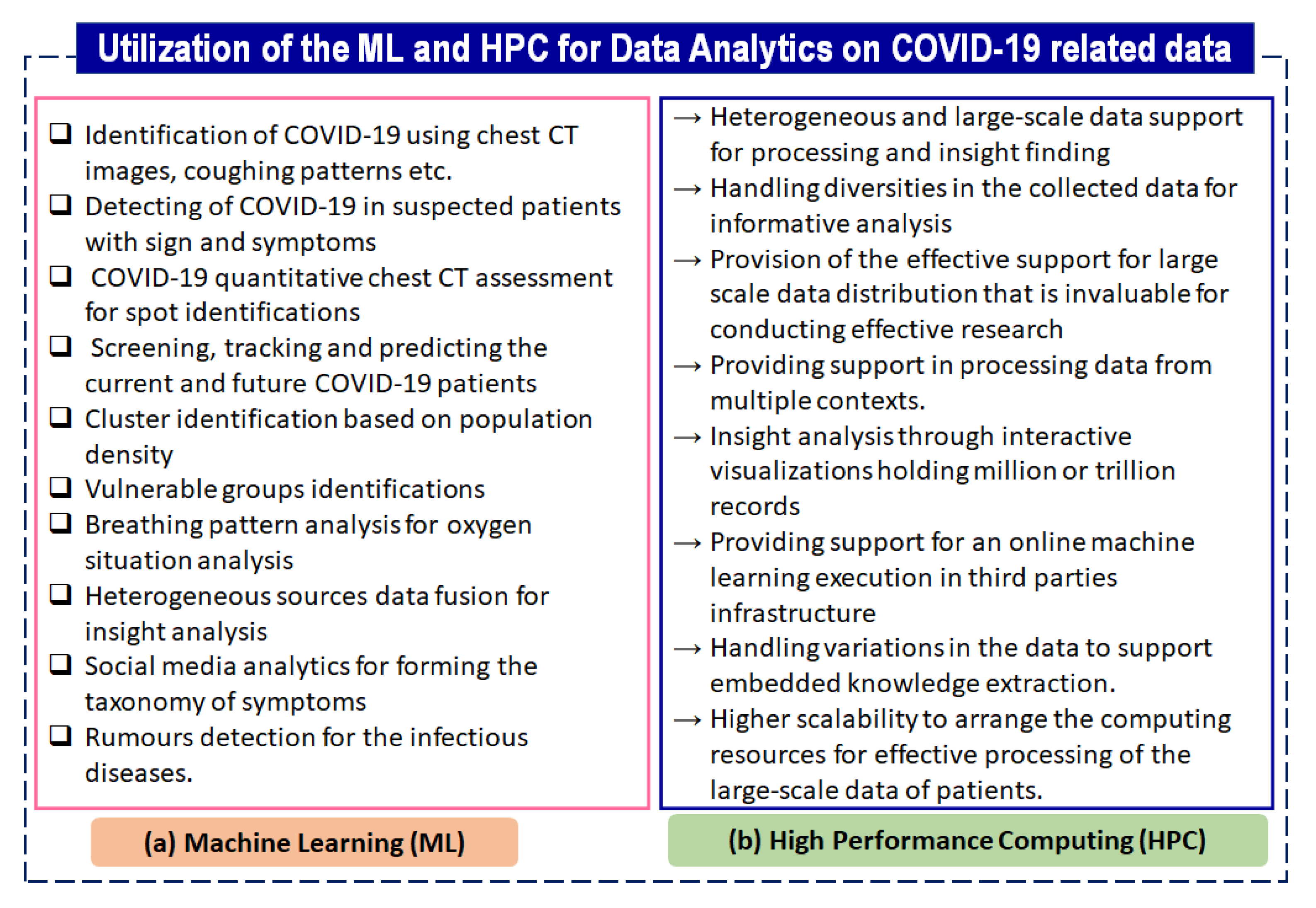
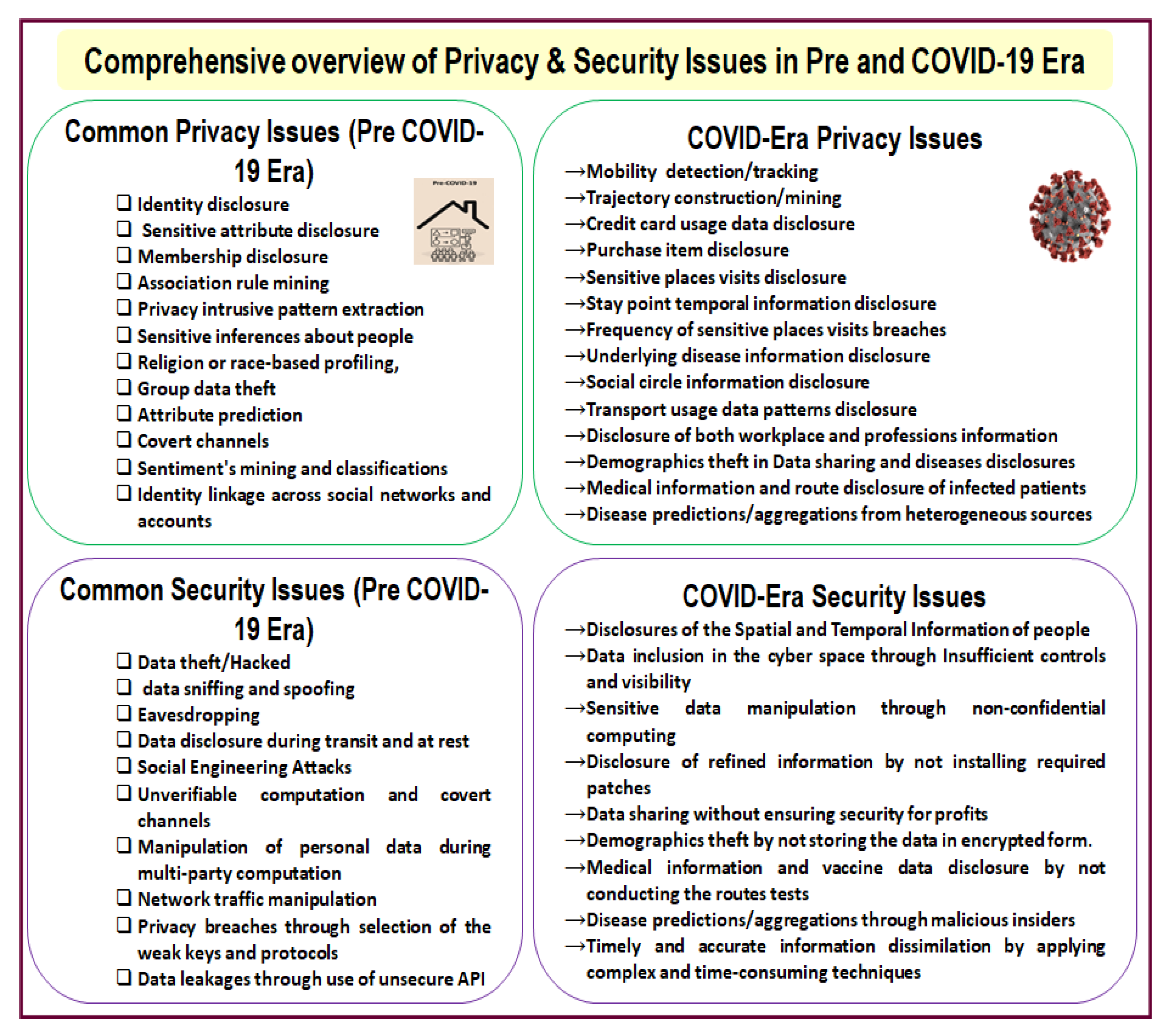
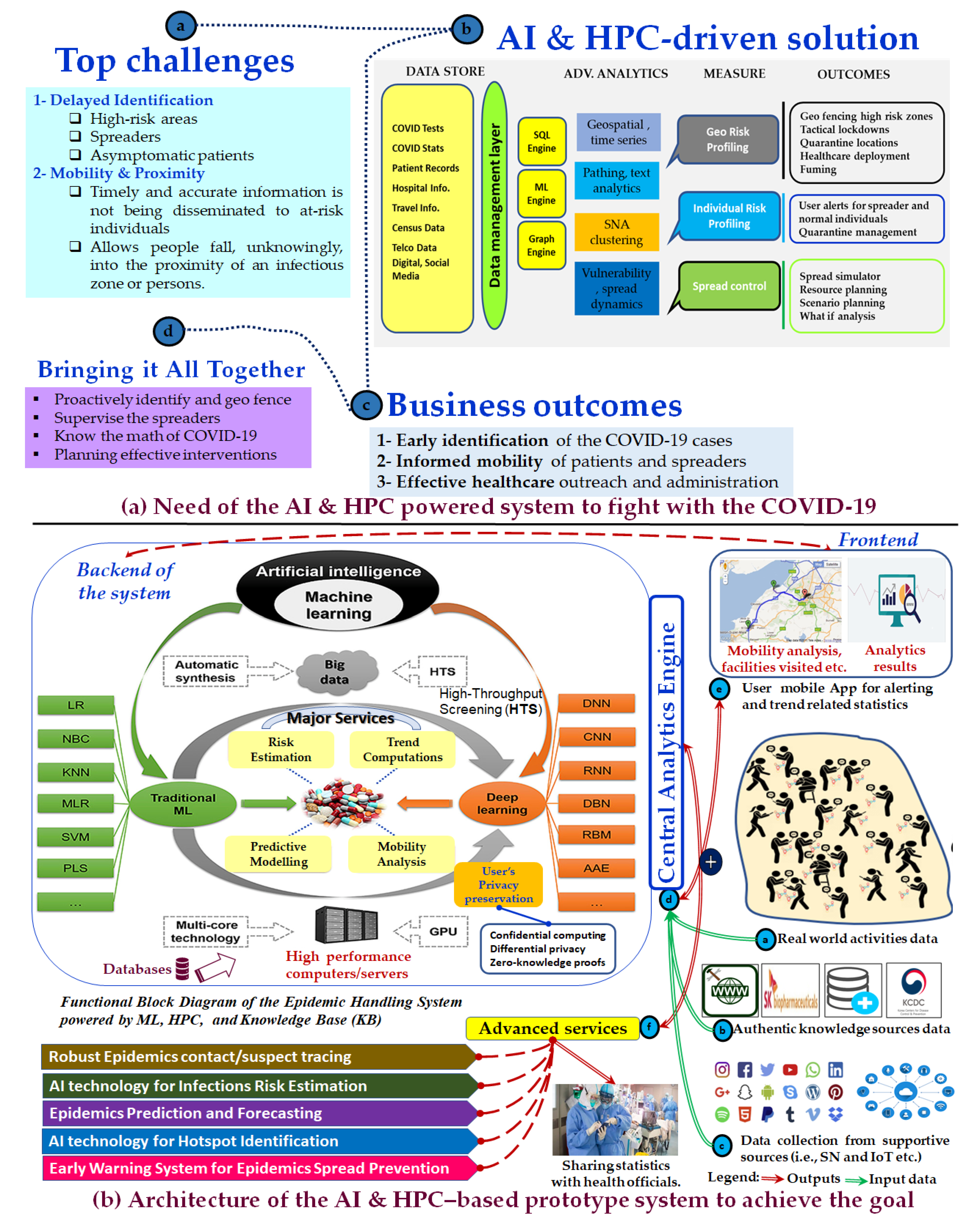
| Phase Number | Phase Name | Tasks Performed in a Respective Phase |
|---|---|---|
| 1. | Collection | Data are collected from relevant people. |
| 2. | Storage | Data are stored in databases for later use. |
| 3. | Preprocessing | Data are cleaned for later use. |
| 4. | Analytics | Data are processed with ML and HPC for insights. |
| 5. | Usage | Data are used for desired purposes. |
| 6. | Distribution | Data are shared for research purposes. |
| 7. | Archival | Data are archived for needs-based use. |
| Category | SOTA Studies | Discussions about Findings and Role in Addressing the Clinical Unmet Needs in COVID-19. | |
|---|---|---|---|
| Study Details | Key Findings of Each SOTA Study | Role in Addressing the Clinical Unmet Needs in the COVID-19 Era | |
| ML | Pinter et al. [28] | Predictions of mortality rate and time series of infected individuals | Outbreak’s modeling and mortality trends analysis |
| Magar et al. [29] | Virus–antibody sequence analysis and Identification of potential patients | Robust identification of antibodies that potentially inhibit COVID-19 | |
| Aminu et al. [30] | Accurate detection of people with COVID-19 with limited data | Effective for the reliable diagnosis of COVID-19 | |
| Zeng et al. [31] | Forecasting of patient survival probability | Age-group-based mortality analysis to provide care to elderly people. | |
| Shah et al. [32] | COVID-19 detection from X-ray images | Help in diagnosing potential suspects as early as possible to mitigate the deadly disease | |
| Ashraf et al. [33] | Predict the severity of disease or chances of death | Significant contribution in separating vulnerable groups for ample care | |
| Prakash et al. [34] | Impact analysis of various policies employed to control the disease | Guidance for effective strategies that can help control the spread | |
| Ullah et al. [35] | Classification of patients with and without COVID-19 | Lowering the healthcare burden of patient diagnosis | |
| Rathod et al. [36] | Effective crisis preparedness and management along with authorities’ responses and mitigation strategies. | Assistance in healthcare workers’ burden analysis | |
| Rathod et al. [37] | Detection of abnormal data for effective analysis | Resource planning and accurate diagnosis | |
| Rashed et al. [38] | Provides public awareness about the morbidity risk of COVID-19 | Consistent and reliable forecasting patterns of the spread/decay phases of COVID-19 | |
| Hu et al. [39] | Feasible analysis model for the treatment and diagnosis of COVID-19 | Effective identifications of key symptoms and medicines for different syndromes | |
| Singh et al. [40] | Reduce the high false-negative results of the RT-PCR | Effectively handles the sensitivity issue that is associated with RT-PCR | |
| Peddinti et al. [41] | Detection of COVID-19 cases in public places | Helps officials in the accurate and faster diagnosis of the virus | |
| Saverino et al. [42] | Changes implementation in rehabilitation services | Staff satisfaction and stress reduction during pandemic times | |
| Lella et al. [43] | Respiratory sound classification for potential patient identification | Classification of asthma sounds, COVID-19 sounds, and regular healthy sounds | |
| Malla et al. [44] | Real-time sentiment analysis of COVID-19 tweets | Tweets prediction related to similar types of infectious diseases in the future | |
| Ibrahim et al. [45] | Accurately diagnosing COVID-19 patients and analyzing severity level | Detecting COVID-19 patients and classifying the severity degree from chest CT slices | |
| Roland et al. [46] | Blood-test-based identification of patients with COVID-19 and estimate the mortality risk | Automatic scanning of COVID-19 in a cost-effective way without any additional efforts | |
| Gros et al. [47] | Accurate estimates of the cumulative medical load of COVID-19 outbreaks | Understanding the outbreak dynamics and predicting future cases and fatalities | |
| Hack et al. [48] | Promising treatments, including the virus’ protein structure and attack mechanisms analysis, and resource planning | Accelerate the science needed to develop treatments and strategies to combat COVID-19 | |
| West et al. [49] | COVID-19 spread analysis among different populations and effective therapeutic response | Virus transmission analysis at a very large scale | |
| LeGrand et al. [50] | Drug discovery for targeting the proteins of the COVID-19 virus responsible for the current pandemic | Drug discovery for COVID-19 by analyzing large-scale docking campaigns | |
| HPC | Vermaas et al. [51] | Virtual screening of billions of potential drug compounds to find COVID-19 proteins | Contribution in developing drugs to combat the current COVID-19 pandemic |
| Pérez-Moraga et al. [52] | Drug repurposing to treat COVID-19 infection | Contribution to the development of a cocktail for anticoronavirus treatments | |
| Mulholland et al. [53] | Provides insights into the inner workings and mechanisms of the molecules of COVID-19 | Can assist in suggesting potential drug candidates | |
| Zaki et al. [54] | Identify drug/lead candidate for better inhibitory activity against the main protease of COVID-19. | Useful to develop a therapeutic agent for COVID-19. | |
| Pathak et al. [55] | Innovative solutions for restricting COVID-19 spread | Guidelines for pharmaceutical companies to devise better cures | |
| Hybrid | Bhati et al. [56] | Combines HPC and ML to accelerate drug discovery | Target proteins analysis to identify lead compounds |
| Bharadwaj et al. [57] | Development of potential vaccines at a much diminished time and lower cost | Tackling pandemics and overcoming the crisis with computing intelligence |
Publisher’s Note: MDPI stays neutral with regard to jurisdictional claims in published maps and institutional affiliations. |
© 2021 by the author. Licensee MDPI, Basel, Switzerland. This article is an open access article distributed under the terms and conditions of the Creative Commons Attribution (CC BY) license (https://creativecommons.org/licenses/by/4.0/).
Share and Cite
Majeed, A.; Lee, S. Applications of Machine Learning and High-Performance Computing in the Era of COVID-19. Appl. Syst. Innov. 2021, 4, 40. https://doi.org/10.3390/asi4030040
Majeed A, Lee S. Applications of Machine Learning and High-Performance Computing in the Era of COVID-19. Applied System Innovation. 2021; 4(3):40. https://doi.org/10.3390/asi4030040
Chicago/Turabian StyleMajeed, Abdul, and Sungchang Lee. 2021. "Applications of Machine Learning and High-Performance Computing in the Era of COVID-19" Applied System Innovation 4, no. 3: 40. https://doi.org/10.3390/asi4030040
APA StyleMajeed, A., & Lee, S. (2021). Applications of Machine Learning and High-Performance Computing in the Era of COVID-19. Applied System Innovation, 4(3), 40. https://doi.org/10.3390/asi4030040







